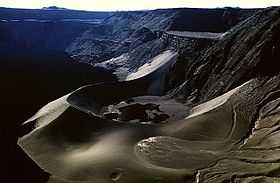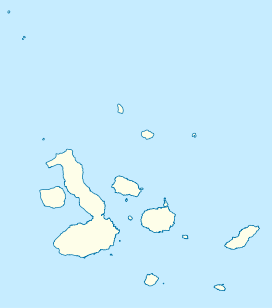Cerro Azul (Ecuador volcano)
| Cerro Azul | |
|---|---|
 | |
| Elevation | 1,689 m (5,541 ft)[1] |
| Prominence | 1,668 m (5,472 ft)[1] |
| Listing | Ultra |
| Location | |
 Cerro Azul Galápagos Islands | |
| Location | Isabela Island, Galápagos Islands, Ecuador |
| Coordinates | 0°55′12″S 91°24′28.8″W / 0.92000°S 91.408000°WCoordinates: 0°55′12″S 91°24′28.8″W / 0.92000°S 91.408000°W |
| Geology | |
| Type | Shield volcano |
| Last eruption | May to June 2008[2] |
Cerro Azul (Spanish: Blue Hill) is a shield volcano on the south western part of Isabela Island in the Galápagos Islands. There is a strato volcano with the same name in Chile.
At a height of 1,689 m (5,541 ft) it is the second highest peak in the Galapagos and due to its topographic prominence of over 1,500 m (4,921 ft) it is categorised as an ultra.[1]
The volcano is one of the most active in the Galapagos, with the last eruption between May and June 2008.
Geology
The Galapagos Islands are believed to be formed from a mantle plume which creates a hotspot of volcanic activity away from plate boundaries where islands then form above it, similar to process that has created the Hawaiian islands.[3] Cerro Azul is at the edge of the upwelling with steep drop offs in the ocean to the West, while the sea is shallower to the east of Isabela Island.[4]
Cerro Azul is one of six coalescing volcanoes on Isabela Island: Ecuador, Wolf, Darwin, Alcedo, and Sierra Negra. Cerro Azul is shaped like a large upturned soup bowl and like the other volcanoes on Isabela Island has a large caldera its one at 4x5 km across is one of the smallest. The caldera shows evidence of collapse following eruptive episodes and reaches a depth of 450 m to 650 m below the rim of the caldera, only Wolf Volcano in the Galapagos is as deep.[2] The volcano is 34 by 22 km at maximum and has a volume of 172 km3. It has steep upper slopes of between 12 and 30 degrees. The shape of the volcano is affected by the sharp ocean drop off to the west where this flank of the volcano slopes steeply to the ocean.[5]
Historical eruptions date back to 1932, but the volcano has had a number of active periods since then in 1940, 1943,1949, 1951, 1959, 1968, 1979, 1998 and most recently in 2008. It is estimated that the surface of the volcano is young, less than 5000 years old and it is estimated that the volcano is about 350,000 years old. The age of Cerro Azul is similar to Sierra Negra and Alcedo and their positioning is not believed to be related to plate movement over the magma plume but instead an interaction between the plume and the lithosphere.[2][5]
The 2008 eruption began in May and included a fissure eruption on the south east flank of the volcano; the eruption in 1998 had also included fissure eruptions on this part of the volcano. The fissure eruptions resulted in lava flowing 10 km (6 mi) from the fissure. There was also an eruption within the caldera. A second fissure opened lower down the slope in early June.[2]
Analysis of the lavas on Cerro Azul show a range of tholeiitic to alkalic basalts and are unlike the neighbouring Sierra Negra or Alcedo volcanoes
A study published in 2006 showed that there was continuous expansion of the volcano prior to and after the eruption in 1998. This expansion would have been due to the emplacement of magma into the magma chamber.[6][7]
Wildlife
The subspecies of giant tortoise on the island is Geochelone nigra vicina, this subspecies is dome shelled and has an overlapping range with the subspecies on the neighbouring Sierra Negra Volcano, Geochelone nigra guntheri, which is a saddleback tortoise. They Cerro Azul tortoises were not affected by the 2008 eruption[8] although the 1998 eruption did force the National Park authorities to move tortoises by land and helicopter. Other tortoises were killed in that eruption, either from lava or associated fires.[9]
See also
References
- ↑ 1.0 1.1 1.2 de Ferranti, Jonathan; Maizlish, Aaron (2005). "Ecuador: 15 Mountain Summits with Prominence of 1,500 meters or greater". peaklist.org. Retrieved June 17, 2013.
- ↑ 2.0 2.1 2.2 2.3 "Cerro Azul". Global Volcanism Program. Smithsonian Institution.
- ↑ Geist, Dennis J.; Naumann, Terry R.; Standish, Jared J.; Kurz, Mark D.; Harpp, Karen S.; White, William M.; Fornari, Daniel J. (June 13, 2005). "Wolf Volcano, Galápagos Archipelago: Melting and Magmatic Evolution at the Margins of a Mantle Plume". Journal of Petrology (Oxford University Press) 46 (11): 2197–2224. doi:10.1093/petrology/egi052. Retrieved June 17, 2013.
- ↑ Chadwick, Bill. "Galapagos bathymetry". VENTS Program: Bill Chadwick (Research Professor). National Oceanic and Atmospheric Administration, United States Department of Commerce. Retrieved June 17, 2013.
- ↑ 5.0 5.1 Naumann, Terry; Geist, Dennis; Kurz, Mark (May 2002). "Petrology and Geochemistry of the Volcán Cerro Azul: Petrologic Diversity among the Western Galápagos Volcanoes" (PDF). Journal of Petrology (Oxford University Press) 43 (5): 859–883. doi:10.1093/petrology/43.5.859. Retrieved June 16, 2013.
- ↑ Baker, S.; Amelung, F. (December 2006). "Deformation of Cerro Azul Volcano, Isabela Island, Galapagos With Radar Interferometry (Abstract)". Eos Trans. Fall Meet. Suppl., Abstract G53A-0871 (San Francisco, U.S.A.: American Geophysical Union) 87 (52). Retrieved June 17, 2013.
- ↑ Baker, Scott; Amelung, Falk (December 2006). "Deformation of Cerro Azul Volcano, Isabela Island, Galapagos With Radar Interferometry (Poster)" (PDF). Eos Trans. Fall Meet. Suppl., Abstract G53A-0871 (San Francisco, U.S.A.: American Geophysical Union) 87 (52). Retrieved June 17, 2013.
- ↑ "Giant tortoises safe as Galapagos volcano ends activity". Google News. AFP. June 3, 2008. Retrieved June 17, 2013.
- ↑ "Cerro Azul - Monthly Reports". Global Volcanism Program. Smithsonian Institution.